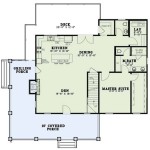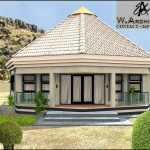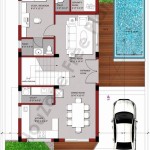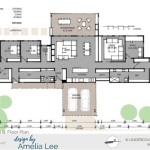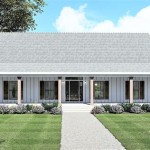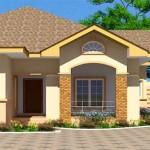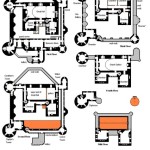Spanish Floor Plans: Courtyard Balcony Designs with Expert Insights
Spanish architectural design, known for its captivating blend of form and functionality, has long been admired globally. A distinguishing feature of this style is the integration of courtyards and balconies, elements that seamlessly merge indoor and outdoor living. These spaces, often adorned with intricate details and lush greenery, offer both privacy and a connection to the natural environment. This article explores Spanish floor plans incorporating courtyard balconies, highlighting key design considerations and offering insights from experienced designers.
The courtyard, or patio, serves as the heart of a Spanish-style home. Traditionally, it's an enclosed space often open to the sky, providing a haven of tranquility away from the bustle of the outside world. Balconies, strategically positioned overlooking the courtyard, enhance the sense of connection between different levels of the house and offer elevated viewpoints. The successful integration of these elements requires careful planning and an understanding of the specific needs and preferences of the inhabitants. Spanish architecture often utilizes symmetrical layouts, enhancing both the visual appeal and the flow of movement within the home.
The choice of materials plays a crucial role in achieving an authentic Spanish aesthetic. Terra cotta tiles, stucco walls, and exposed wooden beams are common elements. These materials, known for their durability and natural beauty, contribute to the overall warmth and character of the design. Balconies are frequently constructed with wrought iron railings, adding an intricate and decorative touch. The use of vibrant colors, particularly in accent pieces and decorative tiles, further enhances the visual appeal and brings a sense of life to the space. Designers often incorporate natural elements, such as stone fountains and lush plantings, to create a sense of serenity and connection to nature.
Maximizing Space and Light
One of the key considerations when designing a Spanish floor plan with a courtyard balcony is maximizing the use of space and light. The courtyard itself often serves as a central light well, bringing natural illumination to the surrounding rooms. The strategic placement of windows and doors is essential to ensure that sunlight penetrates deep into the interior spaces. Balcony design should also consider the shading effect it provides. Overhanging balconies can protect lower-level rooms from direct sunlight, reducing the need for artificial cooling. Designers often employ strategies to bounce light around the courtyard, maximizing its effectiveness in illuminating the adjacent spaces. Integrating skylights can further enhance natural light penetration, particularly in areas that are not directly adjacent to the courtyard.
The layout of rooms surrounding the courtyard is also crucial. Open floor plans connecting the living room, dining room, and kitchen to the courtyard create a seamless flow between indoor and outdoor spaces. Large sliding glass doors can further enhance this connection, allowing for easy access to the courtyard and blurring the lines between the interior and exterior. The placement of bedrooms, bathrooms, and other private spaces should take into account the desired level of privacy and separation from the main living areas. Courtyard balconies can provide a private outdoor space for bedrooms, offering a place to relax and enjoy the fresh air.
Furniture selection and placement also contribute to the overall sense of space and light. Light-colored furniture and minimal clutter can help to maximize the feeling of openness. Mirrors can be strategically placed to reflect light and create the illusion of more space. The use of natural materials, such as wood and wicker, can further enhance the sense of connection to the outdoors. Outdoor furniture on the balcony should be durable and weather-resistant, designed to withstand the elements and provide comfortable seating for relaxing and entertaining.
Enhancing Privacy and Security
While courtyards and balconies are designed to connect the interior with the exterior, enhancing privacy and security is also a critical consideration. Courtyard walls provide a physical barrier, protecting the space from prying eyes and unwanted entry. The height and design of these walls should be carefully considered to balance privacy with the desire for natural light and ventilation. Balcony railings can also contribute to security, providing a barrier against falls and deterring unwanted access. The use of wrought iron railings with intricate designs can enhance both security and aesthetic appeal.
Landscaping can also play a role in enhancing privacy. Tall hedges, trees, and climbing vines can create a natural screen, blocking views from neighboring properties and providing a sense of seclusion. The strategic placement of plants can also help to soften the harshness of the courtyard walls and create a more inviting atmosphere. Consider using plants with fragrant flowers or foliage to add an extra sensory dimension to the courtyard experience. Designers often incorporate water features, such as fountains or small ponds, to create a soothing and tranquil environment while masking external noises.
Security systems, such as alarms and cameras, can also be integrated into the design to provide an added layer of protection. Motion sensors can be placed around the perimeter of the courtyard to detect any unauthorized entry. Security cameras can provide visual surveillance of the courtyard and surrounding areas. The control panel for the security system should be placed in a convenient and discreet location within the house. A well-designed lighting scheme can also enhance security by illuminating the courtyard and surrounding areas at night, deterring potential intruders.
Integrating Sustainable Design Principles
Modern Spanish floor plans increasingly incorporate sustainable design principles, minimizing environmental impact and maximizing energy efficiency. Passive solar design, which utilizes the sun's energy for heating and cooling, is a key element of this approach. The orientation of the house, the placement of windows, and the use of shading devices are all carefully considered to optimize solar gain in the winter and minimize it in the summer. Courtyards can play a significant role in passive cooling by promoting natural ventilation and providing shade. The thermal mass of the courtyard walls can also help to regulate indoor temperatures, keeping the house cooler in the summer and warmer in the winter.
The selection of sustainable materials is another important consideration. Locally sourced materials, such as adobe bricks or recycled wood, can reduce the environmental impact of construction. Low-VOC paints and finishes can improve indoor air quality. Energy-efficient windows and doors can minimize heat loss and gain. Water-efficient landscaping, such as drought-tolerant plants and drip irrigation systems, can conserve water. Rainwater harvesting systems can collect rainwater for use in irrigation or other non-potable purposes. Designers often incorporate green roofs, which provide insulation, reduce stormwater runoff, and create a habitat for wildlife.
Energy-efficient appliances and lighting can further reduce the environmental impact of the house. Solar panels can generate electricity, reducing reliance on fossil fuels. Smart home technology can automate lighting, temperature control, and other systems, optimizing energy consumption. Consider using LED lighting, which is more energy-efficient than traditional incandescent or fluorescent bulbs. A well-designed Spanish floor plan with a courtyard balcony can be both beautiful and sustainable, providing a comfortable and environmentally friendly living space for years to come.
In conclusion, designing a Spanish floor plan with a courtyard balcony involves a complex interplay of architectural elements, material choices, and design principles. By carefully considering the factors outlined above, homeowners and designers can create spaces that are both aesthetically pleasing and functionally efficient. The integration of sustainable design principles further enhances the value and longevity of these homes, ensuring that they remain a desirable and responsible choice for generations to come.

Plan 82009ka Spanish Colonial With Central Courtyard

Spanish House Plans Monster

Tuscan Style House Plan 4480 Villa Roberto

Home Plan Casoria Tuscan House Plans Design Sater Collection

Mexican Hacienda Floorplan Love The Layout

Small Spanish Contemporary House Plan 61custom Modern Plans

Home Plan Casoria Tuscan House Plans Design Sater Collection

Mediterranean Home With 5 Bdrms 3327 Sq Ft Floor Plan 108 1370

Plan W33047zr Narrow Lot Florida Mediterranean Green Net Zero Ready Spanish House Plans Home Designs

Beautiful Examples Of Modern Spanish Mediterranean Homes Edward George

